The article “Babak Khorramdin – The Freedom Fighter of Persia” written by Mahbod Khanbolouki was originally published in the Ancient Origins venue on January 21, 2015. The version printed below has been slightly edited.
Readers interested in this topic can also read and download the below article as well:
= = = = = = = = = = = = = = = = = = = = = = = = = = = = = = = = = = = = = = = = = = = = = = = = = = = =
The Umayyad- and Abbasid Caliphate of the Arabs had invaded and occupied the Sassanid Persian empire for 144 years when in 10 July 795 CE, a child was born in a village called Balal Abad situated near modern day Ardabil in northwestern Iran. This child would grow up to become the most prominent rebel leader of the Persians and he would create the largest rebel force the Arabs had ever faced anywhere in the Islamic Caliphate. He fought the invading Arabs for regaining control over Persian territories in order to liberate the Persian people and to restore Persian culture. He would be known as Babak Khorramdin.
Babak lost his father Merdas in his early childhood which resulted in him taking on the responsibility of his family, including his mother and his two younger brothers. His mother Mahrou worked as a nurse for infants while Babak himself worked as a cowherd until he was twelve years old. By the age of eighteen he was already involved in arms trade and business. He enjoyed music and singing and learned to play the Persian string instrument called tambour. A number of stories have been told about him. One story says that Babak was sleeping under a tree during an afternoon when his mother saw his hair and chest drenched in blood. But when his mother quickly woke him up and he stood on his feet, all blood had vanished and he was unharmed. Based on what she had witnessed, she told Babak that he had a great task ahead of him.
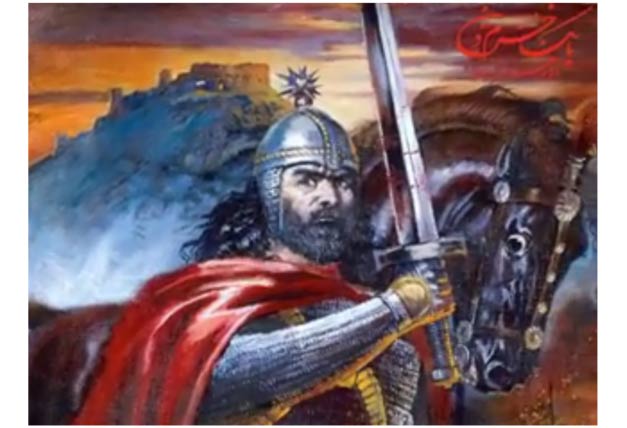
A conjectural image Babak Khorramdin (Source: Ancient Origins). Note the Bazz castle in the mountainous background.
The Khorramian sect
One winter day, a wealthy man named Javidan Shahrak was on the way home from the city of Zanjan where he had gained the leadership of a Persian rebel group called the Khorramian sect established in the nearby highlands. Due to a violent snow storm, Javidan couldn’t continue his journey and had to find shelter. By chance, he found the home of Babak and knocked on the door. His mother welcomed him into their home and lit a fire for him. During his stay, Babak took care of Javidan’s horses and showed good manners towards the guest. His level of intelligence impressed Javidan and when the time had come for Javidan to leave, he asked Mahrou whether he could take Babak with him to work in his farms. Javidan also promised her that he would send plenty of money. She accepted his request and by this event, Babak joined the Khorramian rebel group and Javidan became Babak’s role model and teacher. After some time, Babak gained the name Khorramdin, meaning of the delightful faith referring to the pre-islamic religion Zoroastrianism which is the ancient native religion of Persia.
As the leader of the Khorramian rebel group, Javidan fought the Arabs alongside Babak Khorramdin around their strong hold in northwestern Persian between the years 807-817 CE until Javidan became wounded in a battle and died in 817 CE. By the time Javidan died, Babak had learnt how to use geostrategic locations, to apply various military tactics and to lead troops. Javidan had chosen Babak as his successor and leader of the Khorramian sect before he died. Multiple rebel groups were scattered throughout the cities of Persia by the time Babak became a leader. Eventually Babak married Banu Khorramdin, the former wife of Javidan who was a female warrior and who fought side by side Babak and his men. Members of the Khorramian group wore red clothes and therefore they were known as sorkh jamegan among people, meaning the red clothed ones .
Beginning of the Rebellion
The same year as Javidan died, Babak started to motivate his followers to come together and to start a rebellion against the Arab Caliphate, and so the rebellion of the Persians begun. Babak started to recruit farmers and rebel leaders from all around Persia and ordered them to go to arms and to spread fear in the eyes of the Arabs. Babak’s popularity increased rapidly and thousands of people joined his movement. There are different accounts of the number of people who joined his rebel army but the number is estimated to be between 100 000 – 300 000 people strong. The army mainly consisted of farmers and when Babak recruited these men, he also trained them for battles. He ordered his men to raid caravans along the Silk Road, to destroy Arab strongholds and to seize villages, which in turn contributed to loss of control in many provinces ruled by the Arabs.
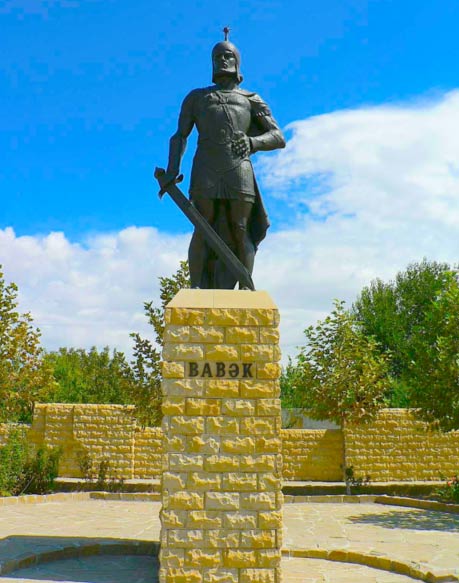
Statue of Babak Khorramdin the Nakhchevan region of the Republic of Azerbaijan in the southern Caucasus (Wikimedia Commons). Kindly note that the Caucasian Republic with the name “Azerbaijan” was not known by this name until May 1918 – the historical Azerbaijan is located in southwest of Iran. The region of the modern-day Republic of Azerbaijan was known as Arran and the Khanates and also as Albania in pre-Islamic times.
In 819 CE, full scale battles between Persians and Arabs were initiated. The Caliphate continuously ordered Arab generals to fight Babak. An Arab general named Yahya ibn Mu’adh was sent to fight the Khorramian rebel group, but failed to defeat Babak. During two years time, armies under the command of Isa ibn Muhammad ibn Abi Khalid continuously attacked Babak’s forces with no success. In 824 CE, Ahmad ibn al Junayd attacked the Khorramian rebel group but ended up captured by Babak. In 827 CE, the Arabs under the command of Muhammad ibn Humayd Tusi attacked and became victorious but could not capture Babak and his closest men. In 829 CE, Babak returned to restore his strongholds and defeated Muhammad ibn Humayd Tusi who ended up getting killed while his Arab army suffered heavy losses.
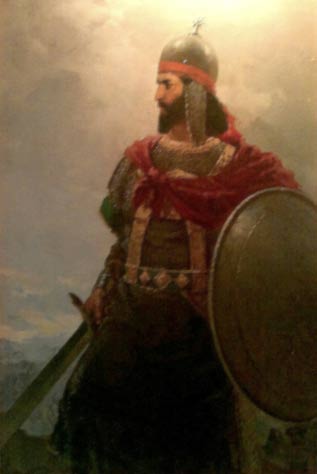
An image of Babak Khorramdin (Source: Ancient Origins).
The stronghold of the Khorramian rebel group was the Castle of Babak which is situated on an altitude of 2600 metres on the mountain Badd (also known as Bazz). The castle is surrounded by mountains and ravines which during ancient times provided protection from invading troops. A handful of Khorramian soldiers could easily wipe out thousands of enemies and the castle was impossible to invade during winter seasons. It was built during the Sassanid dynasty (224-651 CE) with foundations built during the Parthian dynasty (247 BC-224 CE). As the brilliant war lord that he was, Babak Khorramdin took full advantage of the strategic location of the castle which had an important role in the numerous victories he had against the Arab generals.
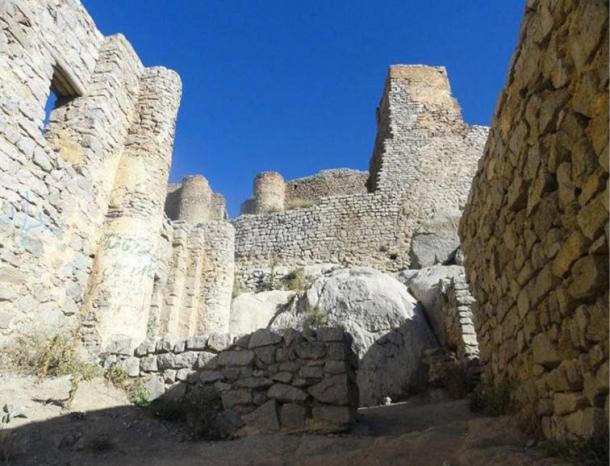
The remains of the Castle of Babak which are visited by Iranians and tourists all year round (Source: Iran Tour Center).
In 835 CE, the caliph of the Abbasid Caliphate named al Mu’tasim ordered his best general to confront Babak Khorramdin and to capture him. His name was Haydar ibn Kavus Afshin and was chosen as the governor of the area where Babak was active. He had been a former compatriot of Babak. In the early days of the Persian rebellion, Afshin made an oath together with Babak to cooperate and defeat the Arab armies and to bring back the power of Persia to the hands of the former Sassanid monarchs. By this time, after 18 years of Persian revolts, Afshin had treacherously started to cooperate with the Arabs in exchange for excessive riches, benefits and to be the head general of the Caliphate army. With the help and resources provided by the caliph, Afshin ordered Arab strongholds, which had been destroyed by Babak and his men, to be rebuilt and reinforced. Al Mu’tasim on the other hand managed to capture one of Babak’s men which by torture was forced to exploit information about Babak’s tactics, territorial strategies and about hidden pathways. Shortly before Afshin attacked the Castle of Babak, Babak had sent a letter to the Byzantine emperor Theophilus in request for military reinforcements but the letter did not reach the emperor in time. Babak and his men had to evacuate the castle and flee. Babak himself together with his wife and a few soldiers fled to Armenia while Afshin plundered and thereafter demolished the castle. While Babak was in the custody of the Armenian prince Sahl ibn Sonbāt, the prince was informed about the large reward for finding Babak. Afshin was informed about Babak’s presence in Armenia and he sent a large army to Sahl ibn Sonbāt’s residence and captured Babak.
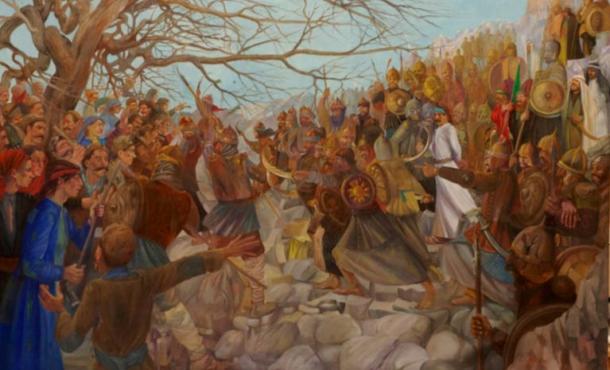
A 2009 canvas oil painting produced in Tehran by Shahab Mousavizadeh depicting the arrest of Babak Khorramdin (in c. 800 CE) by the Caliphate (Source: Shahab Mousavizadeh).
Babak Khorramdin was held in the presence of the caliph in the city of Samarra and was sentenced to death in 838 CE. Before he was executed, his hands and feet were cut off and it is said that in his agony, Babak washed his face with blood pouring out of his cuts. When the caliph asked him what he was doing, Babak answered that he wouldn’t let the Arabs see his pale face when he was dead so that they wouldn’t think he died with fear of the Arabs. He was decapitated and his head was later sent around the cities of Persia in order to spread fear among Iranians. His body was hanged on the walls of Samarra.
For 21 years, Babak Khorramdin successfully lead a major rebellion which brought the Arabs to their knees one battle after another. Ultimately, he wasn’t defeated by the Caliphate but by treacherous allies. He will always be remembered as the Persian hero who sacrificed his life for freedom and his cultural heritage. He was a brilliant leader and is very much alive today in the minds of Iranians just as he was back in time. Today Iranians visit the ruins of his castle 10 July every year to honor the great legend and his men.



